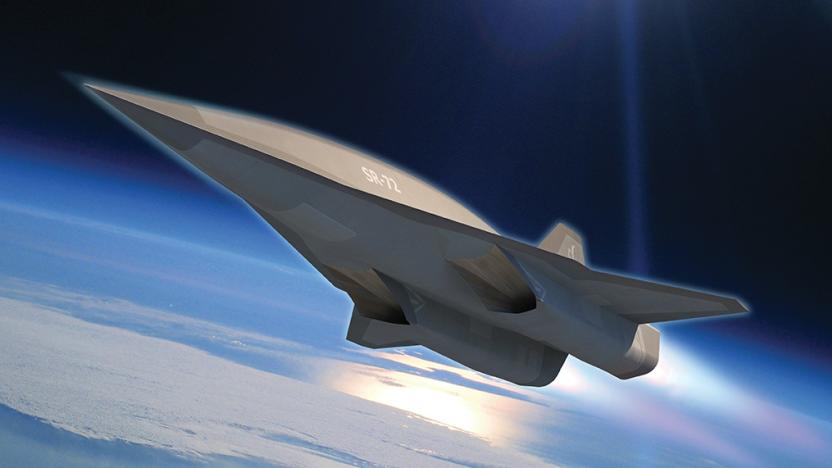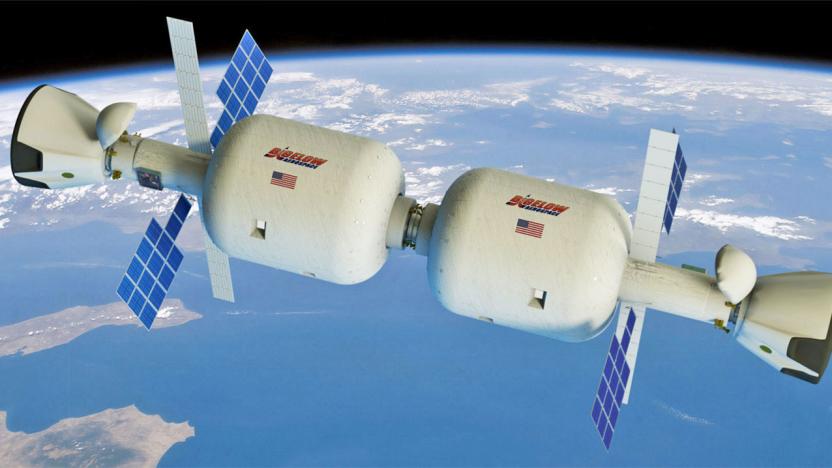aerospace
Latest

Italian researchers have built a humanoid robot that may one day fly like Iron Man
Take one part Richard Browning, one part Tony Stark, mix well and you've got yourself an adorable mini Ultron.

This 3D-printed foam expands up to 40 times its original size
A team from UC San Diego developed a foaming resin that can expand to up to 40 times its original volume.

Bigelow Aerospace laid off all of its workers
Bigelow Aerospace -- the company that created the inflatable module attached to the International Space Station -- laid off 20 employees last week. Yesterday, it laid off its 68 remaining workers. According to SpaceNews, one employee described the company's decision to halt operations and let go of its employees as the results of a "perfect storm of problems," one of which was the coronavirus pandemic. A spokesperson told SpaceNews that Bigelow Aerospace plans on re-hiring the laid-off workers, but other sources are dubious of this claim.

Researchers create '2D' gold a million times thinner than a fingernail
Scientists have created the world's thinnest gold. At just two atoms thick, the material is one million times thinner than a human fingernail, which is big news for the tech industry. Gold is already used in a range of applications such as engineering, aerospace, as well as in medicine -- gold nanaoparticles play a significant role in cancer treatment, for example -- but in a "2D" form it has the potential to be used even more efficiently.

Bosch's reworked automotive sensors can help control flying taxis
As companies from Boeing and Uber to Lilium work to develop flying taxis, Bosch wants to make the sensors they'll require more accessible. The company says conventional aerospace technology is too expensive and bulky to use in autonomous flying vehicles. So, today, Bosch announced a plug-and-play sensor box that adapts automotive industry sensors for use in flight.

NASA's aircraft modifications make planes 70 percent quieter
While NASA's research often makes headlines for advancements that could facilitate space exploration -- like, say, more portable nuclear reactors or X-ray navigation -- it also looks into tech to help us here on Earth, too. The agency just completed a series of flights testing out new airframe components that could reduce the noise they generate when landing by over 70 percent. That could mean quieter airports and happier communities surrounding them, and consequently fewer noise complaints to the FAA.

Lockheed's 'Son of Blackbird' spy plane might already be here
The Lockheed Martin SR-71 Blackbird is one of the most recognizable aircraft designs in history. Few other planes have captured the public's attention and imagination in quite the same way as the SR-71 has since it was declassified in 1990 (nearly 30 years after it entered service). And though we're now two decades on from the Blackbird's retirement, America's need for supersonic, high-altitude surveillance has not diminished.

Bigelow Aerospace plans an inflatable habitat for lunar orbit
Bigelow Aerospace has been working on inflatable space habitats for a while now. The company sent a small inflatable unit to the ISS that added a small living area on the space station and it partnered with United Launch Alliance (ULA) last year on plans to launch its B330 module to Low Earth Orbit. Now, the company has just announced that it will continue the partnership and send another B330 inflatable habitat to Low Lunar Orbit by 2022.

Researchers figure out trick to a fruit fly's acrobatic flight
If you've ever tried to swat a fruit fly out of the air, you know how crafty the little buggers can be at avoiding your swings. Turns out that not only are they incredibly agile, they're super efficient as well, using only 12 muscles (each controlled by a single neuron) to propel itself through the air. And, thanks to the efforts of a team at CalTech, we know why these flies are so nimble. It's all in the muscles.

Now we can 3D print ceramics
Despite being able to build just about anything with 3D printing, until now items have been limited to polymer plastics, a handful of metals and glass. However, researchers at HRL Laboratories have announced a significant advancement in additive manufacturing: the ability to print ceramics. The trick, the HRL team figured out, was to not heat ceramic powder. Doing so generates too many microscopic flaws that can lead to cracks and fractures. Instead, the team developed a material they're calling "preceramic polymers" that convert to ceramic when heated. Essentially, the HRL team prints out the 3D design using these preceramic polymers and then fires the resulting item (like in a kiln) to harden the material into ceramic.

Flying the Icon A5, an almost affordable personal plane
As we cut through the skies over the Hudson River and traced a loop around the Statue of Liberty, I spent as much time glancing down at the instrument cluster as I did peering out the window. That might seem like a huge waste of time given the views I was taking in but I couldn't help it: It's not often I wind up in the cockpit of a plane looking at dials and readouts, much less ones that make sense to me. That's because a pilot and I were tooling around in an Icon A5, a $189,000 "light sport" amphibious aircraft that's eager to shrug off the complexity of (relatively) cheap aviation. After nearly ten years of development and fighting for FAA approval, the A5 is almost ready to make the skies accessible to the well-heeled.

ICYMI: Tech for rhinos, smarter spacecraft design and more
#fivemin-widget-blogsmith-image-814839{display:none;} .cke_show_borders #fivemin-widget-blogsmith-image-814839, #postcontentcontainer #fivemin-widget-blogsmith-image-814839{width:570px;display:block;} try{document.getElementById("fivemin-widget-blogsmith-image-814839").style.display="none";}catch(e){}Today on In Case You Missed It: Small cameras are being implanted in endangered rhino's horns to save them from extinction. An aerospace company designed a new engine which could power a spacecraft via Earth-based microwave emitters. And theme-park goers who love 4D immersive-motion rides may soon be able to put similar tech on their living room sofa.

Lockheed Martin buys helicopter maker Sikorsky
Don't look now, but Lockheed Martin just became an even larger aerospace powerhouse. The aircraft maker has acquired helicopter maker Sikorsky (best known for the UH-60 Blackhawk) for $9 billion. The two have already been partners on programs like the MH-60, but this gives Lockheed its very own rotary-wing team. If a customer wants something that flies, the company will have it covered. The buyout is poised to close by late 2015 or early 2016, provided everything goes smoothly.

Lockheed Martin's 360-degree laser turret gets cleared for take-off
Lockheed Martin has an affinity for lasers -- that much is apparent. Not satisfied with simply having ground-based energy weapons, though, the outfit has recently tested its airplane-mounted death ray over the skies of America's High Five, Michigan. The Aero-optic Beam Control (or ABC, as its friends are fond of saying) was recently run through its paces to prove airworthiness, among other things. The kicker here is that the laser can rotate 360 degrees and eliminate targets from basically any direction. Yeah. Lockheed says that the turret's been designed to engage bogies at basically any position and there's tech in place to counterbalance any turbulence caused by the protruding sphere (pictured above). The trials aren't done just yet however, and they'll only increase in complexity to further prove the system's military-aircraft mettle as time wears on. So, you know, enjoy hiding out in your secret lair while it lasts.

Boeing gives retired F-16 fighter new life as a drone (video)
If "fighter pilot" was your desired career, you'd better hurry up now that Boeing is looking to replace you with a robot. The company has retrofitted a retired F-16 fighter, which had laid dormant for 15 years, into a drone for combat training missions. Rather than risking life and limb in the cockpit, two test pilots can maneuver the craft, now called QF-16, from Florida's Tyndall Air Force Base -- presenting rookie flyers with a target that can hit 9G and supersonic speeds. There's an explanatory video below, which explains the benefits of computer controlled planes but... wait a minute, isn't this the plot of Stealth?

BAE Systems speaks about unmanned ASTRAEA: no reason it can't stay in air 'for weeks'
BAE Systems' ASTRAEA isn't a new concept -- the company's been playing up its unmanned potential for quite some time now -- but it's all seeming entirely less pie-in-the-sky now that the Farnborough Airshow has kicked off. Typically, UAVs are thought to be smaller, drone-type apparatuses; these things are typically used in military exercises where remote gunfire or reconnaissance is required. Clearly, it's about time someone asked the obvious: "Why?" Lambert Dopping-Hepenstal, Engineering Director Systems and Strategy, Military Air and Information at BAE and ASTRAEA Program Director recently spoke at the aforesaid event, noting that this particular aircraft could "open up a new market." He continued: "Current search and rescue aircraft are limited by human endurance, however with a UAV there's no reason why they can't stay up for weeks." Sadly, he also affirmed that there aren't any plans to ship actual humans up in the air without a pilot onboard, but if you're rich and mettlesome enough to pull it off yourself... well, be sure to send us the video. Also, Godspeed.

BAE Systems' NAVSOP does positioning without GPS, makes sure the only jammin' going on is yours
Just in case GPS and GLONASS didn't make for enough of an acronym soup, BAE Systems wants to add one more to the navigation broth. NAVSOP (Navigation via Signals of Opportunity) uses some of the basic concepts we know from cell tower triangulation and WiFi location-finding to lock down a position, but goes much further to geolocate from nearly anything that pushes out a signal, such as nearby radios and TVs. It doesn't even need to know what kind of signal it's looking at, and it can get its position in places there's no GPS to work from, whether it's in an urban canyon or the natural kind. BAE is most excited about the prospects of ending GPS jamming against soldiers and UAVs, once and for all: not only is the new technology mostly impervious to attempts to block its signal, it can use the jamming attempt itself to get the position fix. Thankfully, the company's roots in defense aren't precluding use for civilians, so there's a chance that future smartphones might never have to use guesswork to get their bearings -- provided that governments around the world sign off on the idea, that is.

DIY unmanned airship soars 95,000 feet above Earth, lays claim to new record (video)
Are you entertaining dreams of launching your own private spacecraft? All you need is about 30 grand in your bank account, and lots of spare time. Last weekend, a company called JP Aerospace sent its unmanned Tandem airship 95,085 feet above the ground -- a height that, according to the company, establishes a new record for remotely controlled airships. In fact, JP Aerospace says this altitude is a full four miles higher than any other airship has ever flown. To pull this off, the team strapped its 30-foot-long aircraft with two balloons, and packed it with a pair of electric motors that manipulated the Tandem's specially designed propellers. It's a relatively simple method, and one that didn't exactly break the bank, either. All told, it took about five years and some $30,000 to launch the aircraft, as part of the company's Airship to Orbit project. The long-term goal is to use the Tandem or similar airships as a launch pad for rockets or other interstellar aircraft. No word yet on when that could happen, but you can float past the break for a brief video on the Tandem, coupled with a brief PR.

Boeing hitches Android to its 787 Dreamliner ride, powers in-flight options with Google juice
Looks like Boeing's decided to get in bed with Android a mile-high in the sky. The aerospace company has exclusively selected Google's mobile OS as the might behind its new class of 787 Dreamliners' in-flight entertainment. Currently in production jets, of which there are over 800 plus orders, will get outfitted with either a Panasonic or Thales model of the 7- to 17-inch screens. And in a strange twist of luxury privileges, first and business class passengers won't get to enjoy the touchscreen tech, as their monitors will be too large and too far out of reach. Instead, an alternate gesture-based control method is being explored by the company for elite travelers, although nothing's been solidified. Don't expect the planes to launch with the typical Android market experience, either -- apparently, "airline-specific apps" are on the way for the nascent fleets' launch. Now, if only they could replace those flight attendants with little green robots.

Japanese spacecraft's 'black box' recorder survives flaming fall to earth
When we reported on Japan's plans to track the re-entry process of its Kounotori 2 spacecraft with a black-box-style recorder, there were still some unanswered questions: specifically, would the REBR (Re-entry Breakup Recorder) sink or swim. Well, according to an announcement from the device's creator, the thing not only survived the fiery plunge to Earth, but it also stayed afloat after plunking down in the South Pacific Ocean on Tuesday. During free fall, the REBR did as it was expected, automatically monitoring, recording, and eventually transmitting data about the re-entry process, and while the thing was admittedly "not designed to survive impact with the water," it continued relaying information even after landing. The next scheduled REBR mission is planned for June -- here's hoping the new guy's as buoyant as its buddy. Full PR after the break.














